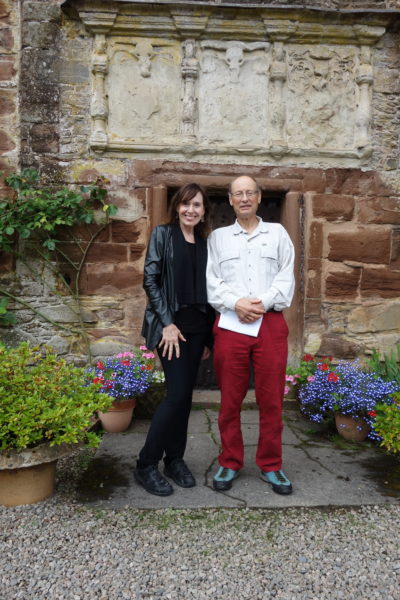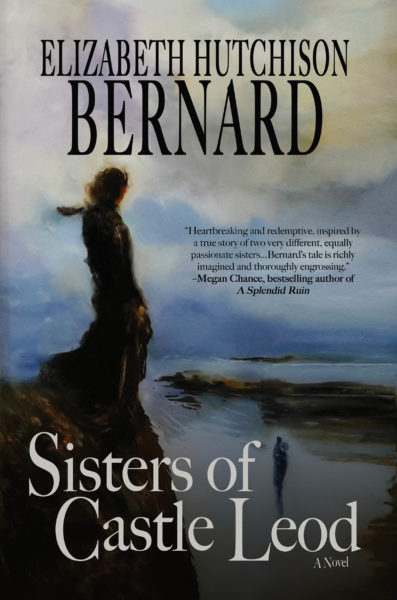The Iconic Castle Leod

I have always been a lover of castles, especially haunted ones. My biggest fantasy is to have a week alone in a haunted castle, wandering the rooms and corridors by night with only a candle for light, alert for signs or sounds of its elusive inhabitants. However, whether I would actually have the courage to do such a thing remains questionable!

While many castles are rumored to be haunted, seldom these days does one have the opportunity for confirmation of a ghostly presence from someone who has experienced it himself. I am speaking of the 5th Earl of Cromartie, John Mackenzie, who told me all about the Night Watchman of Castle Leod (pronounced loud), a ghost that he and many Mackenzies before him have encountered. Our conversation took place during a private tour of the castle in 2019, when I was just starting to research my biographical historical novel SISTERS OF CASTLE LEOD. One of the sisters is the earl’s grandmother, Sibell Lilian Mackenzie, 3rd Countess of Cromartie, the novel’s narrator.
Castle Leod, in Strathpeffer, Scotland, is located on what is believed to be the site of an ancient Pictish fort established before the 12th century. The Norse had a hand in erecting the castle’s original stone keep, but Castle Leod did not assume its present appearance until the end of the 15th century. Unlike many castles that have been added onto over the centuries, “modernizing” their appearance, additions to Castle Leod built during the Victorian and Edwardian eras are neatly tucked behind the old tower to preserve the castle’s ancient flavor. The original castle was constructed as a fortress, with walls six to eight feet thick, and equipped with splayed gun loops and arrow-slit windows. Iron grates still protect many of the small windows. Remnants of a curved lower wall may be what is left of battering ram defenses. The castle has a dungeon in the basement, complete with the unidentified bones of at least one unfortunate prisoner. A hanging tree and drowning pool (the latter considered a kinder death, reserved for women prisoners) are features of the castle’s otherwise pastoral setting.
The castle was granted to John of Killin, 10th chief of Clan Mackenzie (1485-1561), after he fought at the Battle of Flodden, and passed down through generations of Mackenzies. From 1746 to 1784, George Mackenzie, 3rd Earl of Cromartie, forfeited the estate due to his support for the Jacobite rebellion. It was restored to the Mackenzies by his son’s efforts and remains the seat of the Earls of Cromartie to this day.
As for Castle Leod’s ghostly inhabitants, I know of only one—the Night Watchman, a 15th century sentry who has been known to appear, from time to time, in the castle’s Great Hall. Readers of my novel SISTERS OF CASTLE LEOD will catch a fleeting glimpse of the Night Watchman in the first chapter, and the ghost plays a subtle supporting role in the unfolding of the novel’s plot. Sibell Mackenzie, a spiritualist and romantic novelist, is a firm believer in ghosts and spirits, while her rebellious sister, Constance, appears not to believe at all in such things—which turns out to be a significant factor in their long and bitter estrangement. Interestingly, the current Earl of Cromartie, and chief of Clan Mackenzie, seems quite comfortable sharing his castle with the Night Watchman. When asked if he had personally seen the ghost, he quickly replied, “Oh yes, of course.”
My visit to Castle Leod was a highlight of the wonderful research trip to the Scottish Highlands that my husband and I took in 2019. To be able to walk along the same corridors and tour the various rooms that my characters actually lived in at the turn of the twentieth century was an incredible experience. While I could not visit every locale that serves as a setting for my novel (notably Constantinople, Turkey, which is now Istanbul, and Tyre, Lebanon), seeing and touching the reality of Castle Leod, and talking with the earl about his grandmother and great aunt, provided the kind of hands-on research opportunity that biographers and historical fiction authors love most. Of course, I was careful to explain to the earl that my book is not a biography of his grandmother but, rather, an imaginative novel inspired by real people and events … which is why I was so excited to learn about the Night Watchman, who readers may consider either real or imagined. Perhaps one day, if I return to the Highlands and am very lucky, I might have the pleasure of meeting this apparently loyal and dutiful ghost.
Do you believe in the possibility of ghosts? Of communication with departed loved ones? Is there an Unseen World, as Sibell believed, that eludes our ordinary senses? Though my work on the novel is finished, these are questions I can’t help but continue to ponder.
This article by author Elizabeth Hutchison Bernard was first published on historicalfictionblog.com.
Sisters of Castle Leod is a Historical Novel Society Editors’ Choice (Feb. 2023) and a recent #1 bestselling New Release in Historical Scottish Fiction.

